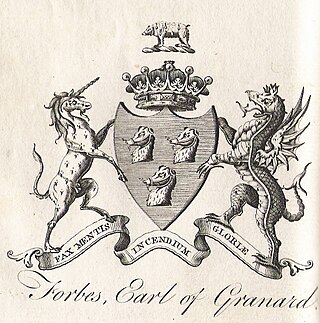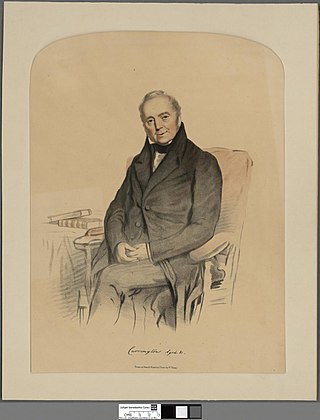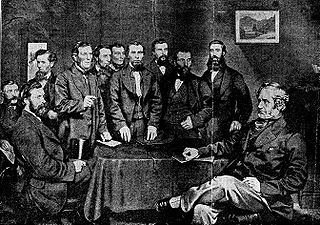Arms
  |
|
Viscount Lambert, of South Molton in the County of Devon, was a title in the Peerage of the United Kingdom. It was created in 1945 for George Lambert, who had been a Liberal Member of Parliament since 1891, with the exception for the 1924-1929 Parliament. He was succeeded by his eldest son, the second Viscount. He had succeeded his father as Member of Parliament for South Molton in 1945, and later represented Torrington in Parliament. On his death the title passed to his younger brother, the third Viscount. The title became extinct on his death in 1999.
  |
|

Viscount Hailsham, of Hailsham in the County of Sussex, is a title in the Peerage of the United Kingdom. It was created in 1929 for the lawyer and Conservative politician Douglas Hogg, 1st Baron Hailsham, who twice served as Lord High Chancellor of the Great Britain. He had already been created Baron Hailsham, of Hailsham in the County of Sussex, in 1928, also in the Peerage of the United Kingdom. Hogg was the son of the merchant and philanthropist Quintin Hogg, seventh son of Sir James Hogg, 1st Baronet, whose eldest son James McGarel-Hogg, 2nd Baronet was created Baron Magheramorne in the Peerage of the United Kingdom in 1887.

Earl of Carlisle is a title that has been created three times in the Peerage of England.

Marquess Townshend is a title in the Peerage of Great Britain held by the Townshend family of Raynham Hall in Norfolk. The title was created in 1787 for George Townshend, 4th Viscount Townshend.

Earl of Scarbrough is a title in the Peerage of England. It was created in 1690 for Richard Lumley, 2nd Viscount Lumley. He is best remembered as one of the Immortal Seven who invited William of Orange to invade England and depose his father-in-law James II. Lumley had already been created Baron Lumley, of Lumley Castle in the County of Durham, in 1681, and Viscount Lumley, of Lumley Castle in the County of Durham, in 1689. These titles are also in the Peerage of England. The title of Viscount Lumley, of Waterford, was created in the Peerage of Ireland in 1628 for his grandfather Sir Richard Lumley, who later fought as a Royalist in the Civil War.

Earl of Dartmouth is a title in the Peerage of Great Britain. It was created in 1711 for William Legge, 2nd Baron Dartmouth.

Earl of Macclesfield is a title that has been created twice. The first creation came in the Peerage of England in 1679 in favour of the soldier and politician Charles Gerard, 1st Baron Gerard. He had already been created Baron Gerard, of Brandon in the County of Suffolk, in 1645, and was made Viscount Brandon, of Brandon in the County of Suffolk, at the same time as he was given the earldom. These titles are also in the Peerage of England. Lord Macclesfield was the great-grandson of the distinguished judge Sir Gilbert Gerard, Master of the Rolls from 1581 to 1594. He was succeeded by his eldest son, the second Earl. He was involved in the Rye House Plot of 1683, was sentenced to death but later pardoned by the King. On his death without legitimate issue in 1701 the titles passed to his younger brother, the third Earl. He had earlier represented Yarmouth, Lancaster and Lancashire in the House of Commons. When he died in 1702 the titles became extinct.

Viscount Torrington is a title in the Peerage of Great Britain. It was created in 1721 for the statesman Sir George Byng, 1st Baronet, along with the subsidiary title Baron Byng, of Southill in the County of Bedford, also in the Peerage of Great Britain. He had already been created a baronet, of Wrotham in the County of Kent, in the Baronetage of Great Britain in 1715. His eldest son, the second Viscount, represented Plymouth and Bedfordshire in the House of Commons and later served as Captain of the Yeomen of the Guard from 1746 to 1747. His younger brother, the third Viscount, was a major-general in the Army. His grandson, the sixth Viscount, was a vice-admiral in the Royal Navy. His son, the seventh Viscount, served as Governor of Ceylon between 1847 and 1850.

Viscount Hood, of Whitley in the County of Warwick, is a title in the Peerage of Great Britain. It was created in 1796 for the famous naval commander Admiral Samuel Hood, 1st Baron Hood. He had already been created a Baronet, of Catherington, in the Baronetage of Great Britain on 20 May 1778, and Baron Hood, of Catherington in the County of Southampton, in the Peerage of Ireland in 1782.

Earl of Granard is a title in the Peerage of Ireland. It was created in 1684 for Arthur Forbes, 1st Viscount Granard. He was a lieutenant-general in the army and served as Marshal of the Army in Ireland after the Restoration and was later Lord Justice of Ireland. He had already succeeded his father as second Baronet of Castle Forbes and been created Baron Clanehugh and Viscount Granard in 1675, also in the Peerage of Ireland. The baronetcy, of Castle Forbes in county Longford, was created in the Baronetage of Nova Scotia on 29 September 1628 for his father, Arthur Forbes.

Earl of Mexborough, of Lifford in the County of Donegal, is a title in the Peerage of Ireland. It was created on 11 February 1766 for John Savile, 1st Baron Pollington, Member of Parliament for Hedon and New Shoreham. He had already been created Baron Pollington, of Longford in the County of Longford, on 8 November 1753, and was made Viscount Pollington, of Ferns in the County of Wexford, at the same time as he was given the earldom. These titles are also in the Peerage of Ireland. He was succeeded by his eldest son, the second Earl. He represented Lincoln in the House of Commons. His son, the third Earl, was Member of Parliament for Pontefract for many years. On his death the titles passed to his son, the fourth Earl. He represented Gatton and Pontefract in Parliament as a Conservative. His son, the fifth Earl, was High Sheriff of Yorkshire in 1877. He was succeeded by his half-brother, the sixth Earl. As of 2018 the titles are held by the latter's grandson, the eighth Earl, who succeeded his father in 1980.

Earl Granville is a title that has been created twice, once in the Peerage of Great Britain and once in the Peerage of the United Kingdom. It is now held by members of the Leveson-Gower family.

Earl Howe is a title that has been created twice in British history, for members of the Howe and Curzon-Howe family respectively. The first creation, in the Peerage of Great Britain, was in 1788 for Richard Howe, 4th Viscount Howe, but it became extinct upon his death in 1799. The second creation, in the Peerage of the United Kingdom, was in 1821 for Richard Curzon-Howe, 2nd Viscount Curzon, and it remains extant.

Viscount Powerscourt is a title that has been created three times in the Peerage of Ireland, each time for members of the Wingfield family. It was created first in 1618 for the Chief Governor of Ireland, Richard Wingfield. However, this creation became extinct on his death in 1634. It was created a second time in 1665 for Folliott Wingfield. He was the great-great-grandson of George Wingfield, uncle of the first Viscount of the 1618 creation. However, the 1665 creation also became extinct on the death of its first holder in 1717.
Viscount Rochdale, of Rochdale in the County Palatine of Lancaster, is a title in the Peerage of the United Kingdom. It was created on 20 January 1960 for John Kemp, 2nd Baron Rochdale. He was Chairman of the woollen manufacturing firm of Kelsall & Kemp Ltd and a former President of the National Union of Manufacturers and Governor of the BBC. The title of Baron Rochdale, of Rochdale in the County Palatine of Lancaster, was created in the Peerage of the United Kingdom on 14 February 1913 for his father, George Kemp. He was Chairman of Kelsall & Kemp Ltd, a Brigadier-General in the Army, and former Member of Parliament for South East Lancashire and Manchester North West. As of 2022 the titles are held by his grandson, the third Viscount, who succeeded his father in 2015.

Baron Carrington is a title that has been created three times, once in the Peerage of England, once in the Peerage of Ireland and once in the Peerage of Great Britain.

Baron Penrhyn is a title that has been created twice. The first creation came in the Peerage of Ireland in 1783 in favour of Richard Pennant, who had previously served as a Member of Parliament for Petersfield and Liverpool. This creation became extinct on his death in 1808. The next creation came in 1866 in the Peerage of the United Kingdom when the Conservative politician Edward Douglas-Pennant was created Baron Penrhyn, of Llandegai in the County of Carnarvon. He had previously represented Carnarvon in the House of Commons and also served as Lord Lieutenant of Caernarvonshire. He was granted the estate of his father-in-law on the condition that he accepted his wife's maiden name, Pennant. Lord Penrhyn was the younger brother of The 17th Earl of Morton. In 1833 he had married Juliana Isabella Mary Pennant, eldest daughter and co-heiress of George Hay Dawkins-Pennant of Penrhyn Castle and in 1841 he assumed by Royal licence the additional surname of Pennant.

George Lambert, 1st Viscount Lambert, PC was a long-serving British Member of Parliament (MP).
George Lambert, 2nd Viscount Lambert, DL TD was a British politician.
South Molton was a parliamentary constituency centred on the small town of South Molton in Devon, in the South West of England. It returned one Member of Parliament (MP) to the House of Commons of the Parliament of the United Kingdom.

John Parker, 1st Earl of Morley FRS, known as 2nd Baron Boringdon from 1788 to 1815, was a British peer and politician.